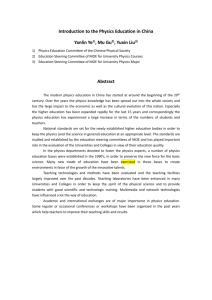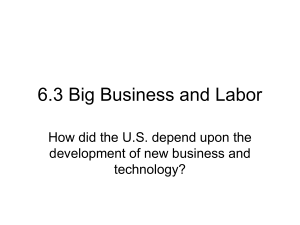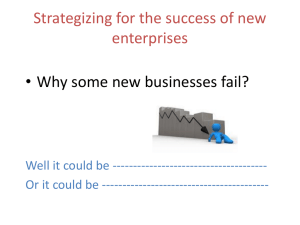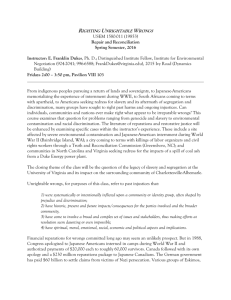Righting Wrongs: Political Battles and the Rise of
advertisement
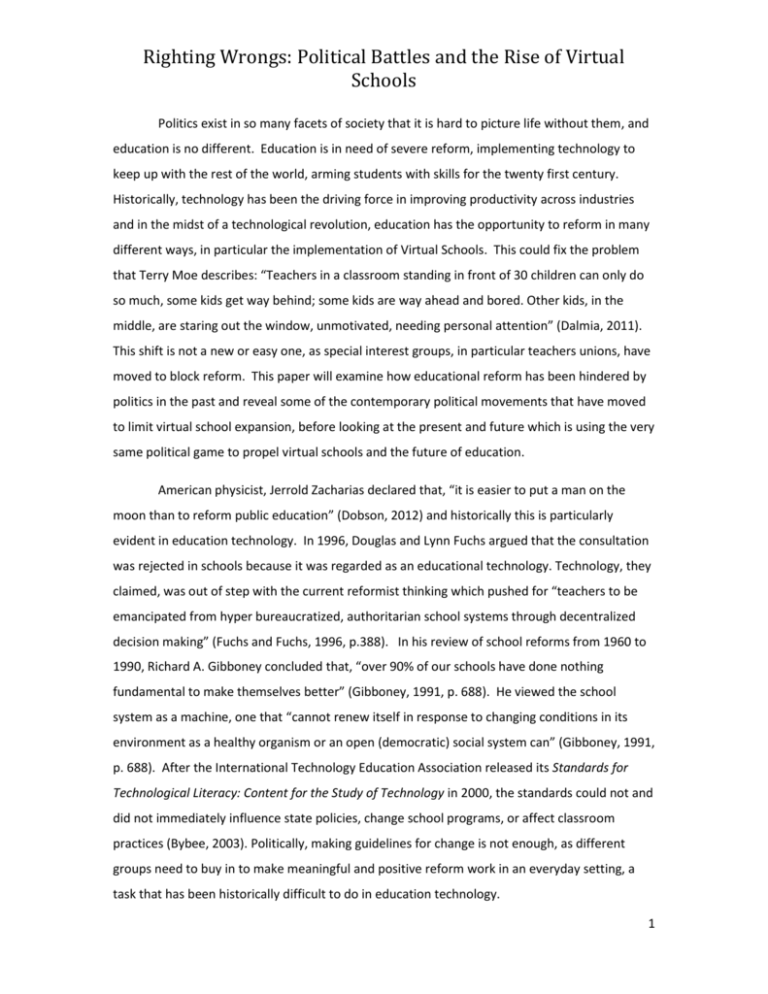
Righting Wrongs: Political Battles and the Rise of Virtual Schools Politics exist in so many facets of society that it is hard to picture life without them, and education is no different. Education is in need of severe reform, implementing technology to keep up with the rest of the world, arming students with skills for the twenty first century. Historically, technology has been the driving force in improving productivity across industries and in the midst of a technological revolution, education has the opportunity to reform in many different ways, in particular the implementation of Virtual Schools. This could fix the problem that Terry Moe describes: “Teachers in a classroom standing in front of 30 children can only do so much, some kids get way behind; some kids are way ahead and bored. Other kids, in the middle, are staring out the window, unmotivated, needing personal attention” (Dalmia, 2011). This shift is not a new or easy one, as special interest groups, in particular teachers unions, have moved to block reform. This paper will examine how educational reform has been hindered by politics in the past and reveal some of the contemporary political movements that have moved to limit virtual school expansion, before looking at the present and future which is using the very same political game to propel virtual schools and the future of education. American physicist, Jerrold Zacharias declared that, “it is easier to put a man on the moon than to reform public education” (Dobson, 2012) and historically this is particularly evident in education technology. In 1996, Douglas and Lynn Fuchs argued that the consultation was rejected in schools because it was regarded as an educational technology. Technology, they claimed, was out of step with the current reformist thinking which pushed for “teachers to be emancipated from hyper bureaucratized, authoritarian school systems through decentralized decision making” (Fuchs and Fuchs, 1996, p.388). In his review of school reforms from 1960 to 1990, Richard A. Gibboney concluded that, “over 90% of our schools have done nothing fundamental to make themselves better” (Gibboney, 1991, p. 688). He viewed the school system as a machine, one that “cannot renew itself in response to changing conditions in its environment as a healthy organism or an open (democratic) social system can” (Gibboney, 1991, p. 688). After the International Technology Education Association released its Standards for Technological Literacy: Content for the Study of Technology in 2000, the standards could not and did not immediately influence state policies, change school programs, or affect classroom practices (Bybee, 2003). Politically, making guidelines for change is not enough, as different groups need to buy in to make meaningful and positive reform work in an everyday setting, a task that has been historically difficult to do in education technology. 1 Righting Wrongs: Political Battles and the Rise of Virtual Schools Public education is run by the government. In a broad sense, teachers and administrators are fearful of the reform that technology can bring. High-tech schools could lure kids away from the traditional model that would threaten job security and many of the values that have been established in the educational status quo. Therefore, it is in their best interests to block the progress that technology promises education systems. While schools have embraced some technology over the past decade - internet access in schools, updated computer labs, ensuring projectors are ubiquitous - the larger scale changes, like virtual schools, have been resisted. Moe and Chubb point to a 2008 study by Education Week which measures how technology is put to use in public schools in the United States. The study measures schools’ “access to technology”, “use of technology” and “capacity to use technology” to come up with an overall score on individual state’s “technology grade”. While there are many factors that can determine why a state is graded where it is, Moe and Chubb found a correlation between a state’s technology grade and union membership. The average technology score drops as union membership increases. This study is looking more at the technology that schools have embraced, but interestingly, even with those manageable changes, “technology appears to be advancing more quickly in states where the unions are weakest.” (Moe and Chubb, 2011, p 112) An even bigger threat to the teacher unions and the stakeholders interested in maintaining the status quo is the emergence of virtual schools where course work is completed primarily through online methods. These schools, which have been popping up throughout North America, offer students who cannot attend face-to-face classes an opportunity to complete courses and receive their diploma, often with superior integration of digital media. These schools are especially suitable for ‘special case’ students: ones that are gifted or who have special needs, ones in need of specialized courses that are not offered at their brick and mortar school, ones in rural or inner city areas, ones that have medical issues that prevent them from attending, and ones that need extra credits for graduation. Virtual schools provide a solution to these students and allow them to not be left behind by the current system. But what if students that don’t fit into ‘special case’ categories opt for this method of instruction? While this will not likely happen for students who are too young to be left home alone, this is an intriguing option for high school students. If an exodus to virtual schools starts to take place, the system as we 2 Righting Wrongs: Political Battles and the Rise of Virtual Schools know it will be turned on its head, leaving traditional educators resistant to change looking for work. This is a direct threat to their self interests and, not surprisingly, has sparked resistance in different forms. In Wisconsin, two school districts, Appleton and Northern Ozaukee, developed virtual charters to attract kids from all around the state. These districts established joint ventures with for-profit companies where the districts ran charter schools, and the companies provided the curriculum, the technology, and the training. In both cases, the school districts increased their enrolment substantially and brought in $5,000 for each new student from the state. The money was used to pay for the costs of the virtual schools and leftover money went to other educational programs. In Appleton, the unions did not want these schools to grow and went to the courts and had these schools declared illegal using the rules of the traditional system that were written before virtual schools were conceived. Their arguments were that children had to be physically present in the charter school that they transferred to, and that the funding per student based on traditional schools was excessive. The courts ruled against on both counts in 2003, which the union appealed. A year later, the union filed a separate case against Northern Ozaukee on similar counts, which it also lost and appealed. The Wisconsin legislature then passed a bill in 2006 that explicitly allowed virtual schools, an effort to avoid these types of lawsuits in the future, but the bill was vetoed by Democratic governor Jim Doyle, who was elected with the support of the union. The cat and mouse game continued in Wisconsin as another bill emerged to protect the twelve virtual schools in the state, which recognized their existence and called for training and certification of their teachers. Governor Doyle threatened to veto again if a cap was not imposed on the total amount of students at 5,250 (compared to the 3,400 at the time of legislation). In this case, the unions and the governor put a lid on a growing problem, while accepting their existence within the system had stopped it from potentially expanding. (Moe and Chubb, 2011) Since Moe and Chubb’s in depth look at Wisconsin’s fight for virtual schools, Governor Doyle was defeated by republican Scott Walker, who took office in 2011. Because of Doyle’s lack of allegiance to the teachers union and sympathies toward the free market, Wisconsin’s education landscape has changed. Walker removed the enrolment cap from the previous administration and the amount of virtual schools has gone up from 18 to 28 in just under two 3 Righting Wrongs: Political Battles and the Rise of Virtual Schools years (Litke, 2012). Further, aggregate student enrolment in virtual schools has increased from 4,189 in 2010-11 to 6,794 for the school year 2012-2013, an increase of 62% (see appendix 1). Similarly in Oregon, the Oregon Connections Academy (a virtual school) was attracting kids from all over the state. The unions got the state legislature to pass a law, saying that any virtual school in Oregon had to have half of its students from its own district, which limited the size and scope of the school. As we saw before, state by state grades on education technology was correlated to the strength of teacher unions. Not surprisingly, as of 2008, the percentage of states with virtual schools has a corollary to lower union membership (Moe and Chubb, 2011). In British Columbia, Bill 33 – the education statutes amendment act, was passed in 2006 which “leveled the playing field, eliminated unnecessary rules, set common definitions and terminology, substantiated accountability processes, and put standards in place for quality” (Learn Now BC, 2012) for virtual schools. Bill 33 was combined with, among other things, a cap in classroom size, something the BC teacher’s union was seeking. The amendment put into focus the government’s vision of virtual schools which aims: To create a quality, dynamic, and engaging learning environment that all students in BC can access. It will not be limited by schedules, calendars, facilities, or location; To ensure student performance in Distributed Learning will continuously improve; and To provide equitable access to education, specifically providing choice for those students who have restricted options, especially students in rural communities, students with special needs, and Aboriginal students. (Learn Now BC, 2012) The implementation still has obstacles in the transference in communication of the changes. The Ministry of Education informs the district superintendents, who relay the information on to their principals, whose job it is to get that information out to the teachers and the community. When Barbara Jones, Principal of Sentinel Secondary in West Vancouver, was asked of what she planned to do, she answered that she had no plans for “overt information giving” and that “we won’t hold anything back, but I don't think we will tell the students that they can take their courses online. We won't start advertising” (Smith, 2006). It is understandable for principals and teachers to be averse to changes as it will require more work, organization and restructuring to blend an online learning environment with a traditional school. Perhaps there is 4 Righting Wrongs: Political Battles and the Rise of Virtual Schools a fear amongst those educators as well, that students will prefer the online delivery, leaving them and their roles in education obsolete. While special interest groups have been mobilizing to block and hinder virtual schools, they are losing ground in the current political climate surrounding their implementation. Florida, which has the largest virtual school in the nation and has mandated that every school district offer online courses (Florida, 2012), has been playing political games to fight back against the unions moves to block reforms. One of Jeb Bush’s top advisors, Patricia Levesque, works for Meridian Strategies LLC, a firm that lobbies on behalf of education technology companies. Levesque advised reformers to use decoy legislation to spread the unions thin and force them to organise against propositions such as paycheque protection, a state wide insurance program to encourage teachers to leave the union, and transparency laws that force unions to release information to the public. This strategy would allow charter school bills to fly under the radar, opening up other fronts in the political battle for and against virtual schools (Fang, 2011). Part of the reason states are following the path laid out by Florida is Barack Obama’s 4.35 billion Race to the Top contest, that was created to award “states that are leading the way with ambitious yet achievable plans for implementing coherent, compelling, and comprehensive education reform, encouraging innovation in schools” (US Department of Education, 2012). States acquire points based on their abilities in assessment improvement, adoption of better data systems and transparency, support for teachers to become more effective, and emphasis on resources for interventions in turning around low performing schools (Whitehouse, 2012). Specifically, one of the criteria for Race to the Top is, “ensuring successful conditions for highperforming charters and other innovative schools [are met]” (US Department of Education, 2012). While unions and special interest groups try to block reform movements in virtual schools, federal incentive has encouraged their development. The results have seen rapid expansion in virtual schools after sweeping legislative success across the United States (Appendix 2, 2011). Fully online, blended, or hybrid programs are now offered in all 50 states and the District of Columbia as part of student education through web based instruction (Kennedy and Archambault, 2012). In fact, five states, Virginia, Idaho, Florida, Alabama and Michigan have 5 Righting Wrongs: Political Battles and the Rise of Virtual Schools signed laws requiring students to take at least one online course prior to graduation (Sheehy, 2012). According to the annual report issued by the Evergreen Education group, “Nearly 620,000 students took an online course during the 2011-2012 school year, up 16 percent from the previous year” (Sheehy, 2012). The political push back to unions is on the rise, but some question if the big winners are the children or the businesses. Perhaps the driving factor behind the political push is the privatization of education in the virtual world and growth for business opportunity. Due in part to the political desire for virtual schools, one study estimates the revenues from the K-12 online learning industry will grow by 43 percent between 2010 and 2015, with revenues reaching 24.4 billion dollars (Fang, 2011). It appears the political right is winning the battles in the legislative fronts to break down the walls, so to speak, of the brick and mortar school by busting unions and promoting privatization. The rise of virtual schools could be seen as a continuum of what Kahn and Keller label technocapitalism, where “a globally networked economy driven by corporate forces of science, technology and a new internet technocultural complex” drive change and shape the future (Kahn and Kellner, 2007, p.433). The frenzy to privatize education has helped push technocapitalism forward in online learning reforms, while tech companies position themselves to take advantage of the growing market. Paulo Friere, the Marxist education reformer, warned of these dangers in his book Pedagogy of the Heart, declaring that, “today’s permanent and increasingly accelerated revolution of technology, the bastion of capitalism against socialism, alters socioeconomic reality and requires a new comprehension of the facts upon which new political action must be founded” (Kahn and Keller 2007, Friere 1997). However, Friere himself used cutting edge education technology (slide projectors) while teaching peasants to read. While conscious of technologies ability to oppress and dominate, he hoped that it could also liberate people from “the drudgery of existence, powerlessness and inequality” (Kahn and Keller, 2007, p.434). The rise of virtual schools gives students the ability to choose their education, making it more democratic, and pushing for a better education. As Moe sees the future, “Technology is going to turn out to be the single biggest force for school choice. It is going to generate a vast array of new options for kids, and it is going to liberate kids from the traditional system that has trapped them for so many years” (Dalmia, 2011, p. 50). In the short run, the political right maybe working to spur the economy and break unions, but in the long run, they 6 Righting Wrongs: Political Battles and the Rise of Virtual Schools are doing the work of the ideological left by promoting a more democratic school system that benefits society as a whole. The times are changing in the world of technology reform and the presence of virtual schools in education. While historically there have been political barriers to educational reform, especially in regards to education technology, political movements have opened doors to the rise of virtual schools. The special interest groups of the left are losing the political battle to protect jobs in favour of online schools, which provides students with more choice and educational advantages associated with online learning. As Moe states, “the government can facilitate the revolution, or it can get in the way. What we need is to encourage a dynamic market, lots of firms with lots of smart people working on this” (Dalmia, 2011). The political landscape is laying the foundation for a brave new democratic world in education that gives learners more choice and options for their learning environment. 7 Righting Wrongs: Political Battles and the Rise of Virtual Schools References Appendix 1 - http://www.postcrescent.com/ic/assets/virtual/enrollment-allyears.pdf Appendix 2 - http://www.thenation.com/interactive/164595/education-reform Bybee, Roger W. (2003). Improving Technology Education: Understanding Reform – Assuming Responsibility. Technology Teacher, May/June, 22-25. Retrieved from www.highbeam.com/.../the-technology-teacher-p5246 Chubb, John E. and Moe, Terry M. (2009). Liberating Learning, Technology, Politics and the Future of American Education. San Francisco, California: Jossey-Bass Dalmia, Shikha (2011). Public Education’s Silver Bullet. Reason, 42, p44-50. Retrieved from Reason.com Dobson, Linda (2012). Early Warnings About Education Crisis. Parent At The Helm. Retrieved from: http://www.parentatthehelm.com/10314/early-warnings-about-todays-education-crisis/ Fang, Lee (2011, Nov 16). How Online Learning Companies Bought America’s Schools. The Nation, Retrieved from http://www.thenation.com/article/164651/how-online-learningcompanies-bought-americas-schools Florida Department of Education (2012). Retrieved from: http://www.fldoe.org/schools/virtualschools/ Fuchs, Douglas and Fuchs, Lynn S. (1996). Consultation as a Technology and the Politics of School Reform. Remedial and Special Education, 17, 386-393. Retrieved from rse.sagepub.com Gibboney, Richard A. (1991). The Killing Field of Reform. Phi Delta Kappan, 72, 682-688. Retrieved from www.questia.com Kennedy, Kathryn and Archambault, Leanna (2012). Offering Preservice Teachers Field Experiences in K-12 Online Learning: A National Survey of Teacher Education Programs. Journal of Teacher Education, 63, 185-200 Litke, Eric (2012, Oct. 19). Virtual school enrollment jumps 38 percent. The Northwestern. Retrieved from http://www.thenorthwestern.com/article/20121020/OSH019802/310200169/Virtual-schoolenrollment-jumps-38-percent Learn Now BC, 2012. Retrieved from: http://www.learnnowbc.ca/information/what_is_dl/History_of_DL.aspx 8 Righting Wrongs: Political Battles and the Rise of Virtual Schools Sheehy, Kelly (2012, October). States, Districts Require Online Ed for Graduation. US News. Retrieved from: http://www.usnews.com/education/blogs/high-schoolnotes/2012/10/24/states-districts-require-online-ed-for-high-school-graduation Smith, Nick (2006, Sept 6). The Quiet Revolution in BC Schooling. The Tyee. Retrieved from: http://thetyee.ca/Views/2006/09/06/OnlineLearning/) US Department of Education (2012). Retrieved from: http://www2.ed.gov/programs/racetothetop/index.html Whitehouse (2012). Retrieved from: http://www.whitehouse.gov/issues/education/k-12/raceto-the-top 9 Righting Wrongs: Political Battles and the Rise of Virtual Schools Appendixes Appendix 1 - http://www.postcrescent.com/ic/assets/virtual/enrollment-allyears.pdf 10 Righting Wrongs: Political Battles and the Rise of Virtual Schools Appendix 2 - http://www.thenation.com/interactive/164595/education-reform 11





